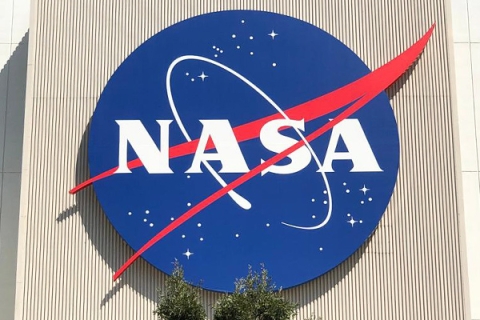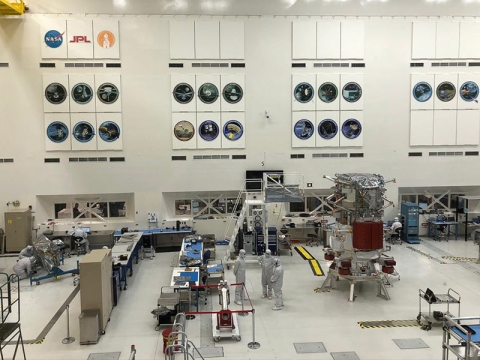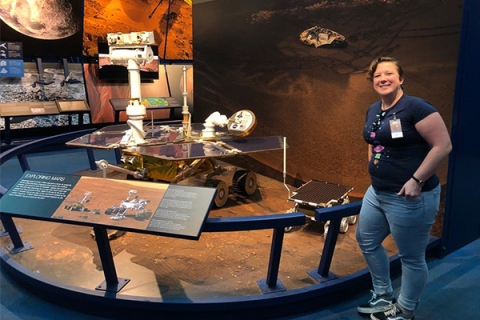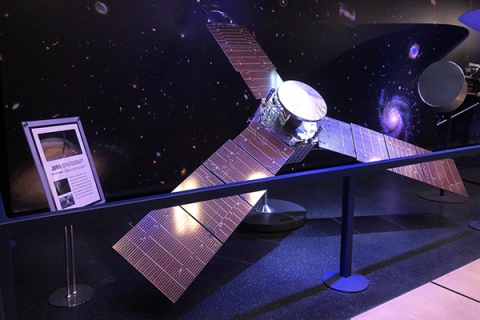

Read about our recent visit to NASA's famous Jet Propulsion Laboratory in California and our future research collaborations with NASA.
4 min read
Members of our Space Project Team spent a week visiting NASA's famous Jet Propulsion Laboratory (JPL) in California. In this blog, we catch up with them to find out what they discovered.
In September 2022, Dr Lucy King, Space Projects Manager, and Professor Adam Amara, Director of the Institute of Cosmology and Gravitation (ICG) at the University of Portsmouth, visited NASA’s world-famous Jet Propulsion Laboratory (JPL) in Pasadena, California.
While there, they met Team-X – a cross-functional team of engineers that completes rapid design, analysis and evaluation of mission designs. Dr King and Prof Amara observed the team undergoing a mission design study for a proposed x-ray space telescope.

The "Europa Clipper" spacecraft in JPL cleanroom. This mission will launch in 2024 and will study Jupiter's moon Europa, one of the most promising places in the solar system to search for extra-terrestrial life.
A new space facility in Portsmouth
There are plans to design and build spacecraft as part of a proposed space facility in Portsmouth. Having seen how the design study process works at JPL – one of the most successful space centres in the world – will be invaluable when it comes time to do the same things in Portsmouth. This, in turn, will help develop a pipeline for UK-based missions too.
The facility will enable the rapid transformation of science concepts to mission designs. This means, for example, that if a new solution is proposed for monitoring and tackling climate change or mitigating the risk of flooding, we could shorten the time it takes for this to be implemented.
By nurturing our relationship with NASA JPL, we are putting the UK in a good position to undertake joint missions, increasing our sovereign space capability and enabling us to be part of ground-breaking missions.
While observing Team-X, Concurrent Design Lead, Kelley Case, explained the process and pointed out important things to be aware of. Dr King was warned about potential “dragons” that they may have to face when setting up a new space institute. This isn’t enough to put her off though. She prefers to think of it like a game of rugby – she’ll have a team and they’ll work together to overcome any opponents and obstacles.

Lucy King and Adam Amara pose next to a scale model of Voyager-1, complete with golden record. Voyager-1 launched in 1977 and became the first human-made craft to leave the solar system in 2012.
Future collaborations with NASA
As well as observing how JPL does things, there was a chance to consider future bilateral mission concepts. Over 10 ideas were discussed, and these could well come to life over the coming years.
In addition to exploring other planets, observing galaxies and looking into the early-stages of the Universe, spacecraft are essential to everyday life. Weather forecasting, SatNav/GPS and much of television depends on satellites, and they’re used to measure climate change, accurately time-keep for bank transfers, monitor crops, track wildlife and more.

Visiting the Von Karman museum and seeing model Mars rovers, just like the ones that are tested in the Mars Yard.

A model of the Juno spacecraft that is currently orbiting and studying Jupiter and its moons.
Exploring “cool space stuff”
The trip provided a chance to visit the key sites around JPL too. This includes the Mars Yard, where research and flight projects test different robotic prototypes. It’s also where engineers practise driving the rovers that currently live on the Martian surface.
The team also had the chance to see JPL’s cleanroom which is currently hosting the Europa Clipper spacecraft. This mission will launch in 2024 and will investigate Jupiter’s icy moon Europa, which is one of the most promising places in the solar system to look for extra-terrestrial life.
Another highlight was visiting the Von Karman museum, which includes a full-scale model of Voyager-1 – a spacecraft launched in 1977 that is still active and in 2012 became the first manmade object to leave the solar system.
At times it might have been hard to contain the excitement at seeing all the “cool space stuff”, according to Dr King, but they remained professional and it was a very successful trip. We’re looking forward to the future of the University of Portsmouth’s collaboration with NASA JPL.
Learn more about our Space research
Space research
Space research helps address fundamental questions about our place in the Universe and allows us to prove or disprove scientific theories developed on Earth, such as gravity, the atmosphere and the geological evolution of other planets.

Institute of Cosmology and Gravitation
Researchers at our Institute of Cosmology & Gravitation explore the evolution of our Universe and aim to inspire the next generation of scientists.

